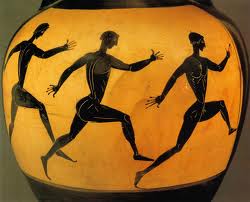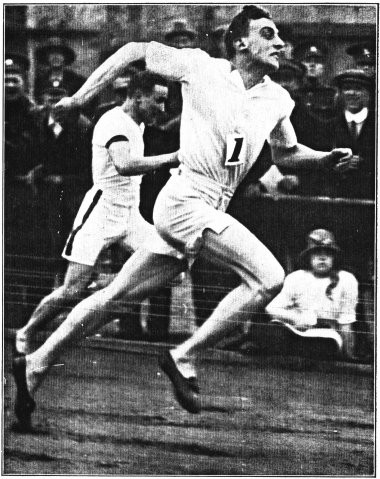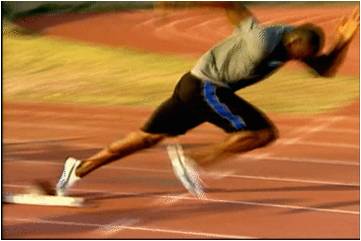This week I read an article in a Dutch running journal about “new” sprinting techniques.(1) Holland might not have a lot of elite sprinters, but we are definitely good at developing “new” sprinting techniques. One is the so-called B&K technique or now called the SST (scissor sprint technique), the other is derived from the technique interpretation of sprinting by Ralph Mann and Loren Seagrave, appropriately called the MST.(2) And, of course, we have seen other sprinting and running techniques also like Pose technique by Dr.Romanov,(3) and little doubt someone else will have invented a new technique in the meanwhile.
In my opinion sprinting technique has not undergone any major changes since the early classic Olympic games, athletes with different individual styles of sprinting have made it to the top.



Why that is? Because every body, has different properties, and because every nervous system is different!!!
In other events in track and field really new techniques were developed, e.g. the shot-put, where the new rotational technique was substantially different from the conventional sliding technique, or in high jump, where the straddle was replaced by the new Fosbury flop.
I think new running techniques are nonsense, but that is too easy, I will explain why I think this is nonsense too.
No.1. “new” approaches to sprinting technique often are developed by people who never coached a decent sprinter, which is surprising in a sense, isn’t it? One would expect elite sprint coaches to be the most innovative since they feel the most pressure to find ways to improve the performances of their athletes.
No.2. the “new” technical approach most of the time refers to an “old school” or a classical and conventional way of looking at technique that seemed to exist, while I never found a consensus amongst sprint coaches about how to sprint. In other words, there never was an unified “old school”. Even in a rather tightly controlled sports environment the former GDR there was no consensus about sprinting technique. One opinion came from Horst-Dieter Hille, the very successful sprintcoach of e.g. Renate Stecher and Marlies Göhr, who focused on development of stride frequency, but at the other hand there was Wolfgang Meier the very successful sprintcoach of Marita Koch and Silke Möller-Gladisch, who focused on development of stride length……
No.3. no matter how plausible, how sophisticated, how refreshing, or how well-established the new view might be, it has not lead to a new and faster generation of sprinters. Yes, of course some people progressed while being trained according to the “new” technical approach, but they would run faster anyway also since all the progress made so far in sprinting, was due to “old school” thinking….. So seeing progress in a sprinter is not proof that a ”new” technique works.
No.4. in general people, are fond of reinventing the wheel and selling it as ‘new and improved”, like old wine in new bags. Especially those people who conveniently forgot to study history of sprint training, so that they could have read their ideas aren’t new at all. Yes, people who forget to study history are indeed doomed to repeat it. I will come back to this later.
No.5. the fable of the blind men touching the elephant applies here, most people have just a piece of the puzzle but they like to think it’s the whole puzzle, focusing on a certain part of the sprinting technique and promoting it being the most crucial part. Front side mechanics has no meaning without back side mechanics, it’s like the chicken and the egg.
No.6. most of the time they have a different explanation for the internal mechanisms while looking at the external action. They see sprinting as falling, bouncing, or scissoring, while I tend to see sprinting as ………..sprinting…..
No.7. different times have lead to different approaches of technique, an eternal question is if one should focus on stride length or on stride frequency, I could never make that decision, so I worked on both, with a little adjustment where needed based on the individual characteristics of the athlete.
No.8. many of the new views are based on plausible sounding assumptions, but no hard data can be shown. An example: there are very little data the use of the different muscle groups in maximum speed running, e.g. by EMG measurement (especially not in high level athletes or high level competitions). And you know that assumptions are the mother of all …. Most of my colleagues and myself are not able to see the semi-tendinosus firing or the contracting tibialis anterior being too late, nor are we able to see reflex-arches being active. We think this mainly exists in the wonderful imagination of our colleagues. The claims of even the existence of a superior technique are not supported by research.
No.9. most proponents of a new technique always conveniently take an elite sprinter (preferably the fastest at the moment) as an example and state he or she is running perfectly according to their view on “new”technique. Usain Bolt and Haile Gebreselassi are often taken as perfect examples of sprinting/running techniques. I would not try to copy them unless you are Usain Bolt or Haile Gebreselassi. The sprinter/runner himself, like Usain or Haile, are completely unaware of doing that …… but almost always trained according to “old” school technical principles…..
No.10. often, it’s not even the “developers” of the new running technique themselves but mainly their dogmatic followers and non-critical believers that make the good intentions of the “new” thinking fail in the first place.
No.11. one of the main limitation is that one is often talking about the relative short phase of maximum velocity and its physical and biomechanical demands and dynamics, while those demands of the start from the blocks or of the acceleration phase are different in nature and in quantity. I tend to say that in the 100 meter sprint no stride is the same like the one before and after, so it becomes hard to talk about an average stride!
No.12. most new developments or improvements have been tried on an individual basis in the past, but without success, if it was only because that new technique was suited for a specific group of individuals.
No.13. let people see a rotational shot put or the gliding technique. Can they see the difference? I guess they can. Do the same for the straddle technique and the Fosbury flop. Can the see it’s a different technique. Now explain the difference in sprinting techniques and let a sprinter run, can they distinguish what kind of technique it is? I bet you they will be in great trouble doing that.
So coming back to point 4. What does history say? Well, you already find all the discussions mentioned already in the book of Toni Nett from 1969, almost 50 years ago! (4) Should we focus on stride length or on stride frequency, should the sprinter fully extend the knee, how important is the active backward “clawing” movement of the front leg, etc.
But even as far back as 1930, Harold Abrahams, the Olympic champion 100 meters in 1924, wonderfully depicted in the movie “Chariots of Fire” (if you haven’t seen it, do it!) wrote very smart things about sprint technique (5)
“The first question is: what is a perfect style? Is there a perfect style or did somebody already display it? There is a much a perfect style as there is a perfect human being…. The main question is how, in which way, we have to use our bodily proportions. Possibly one will find small differences in style, leading to seemingly losses in sprinting speed, but these differences are based on the personality of the sprinter, so that attempt to change this will disrupt his style. A mistake of US coaches is that they try to teach all their sprinters run with the same style, but one style does not fit all.”
More recently Charlie Francis stated: “Technique has not changes much since the days of Jesse Owens”(6)
The discussion about sprinting technique or possible improvements on it, are not new, but it’s the modern information technologies that make it possible to give those ideas a wider audience. How many people have read these rare, classic books about track and field or about sprinting, from before let’s say even 1980?
New sprinting techniques are focusing or a. on a part of the total sprinting movement only, or b. find another explanation for “classical” running dynamics. In the end it doesn’t matter what you see or think.
Limited bibliography about sprinting technique:
1-Heusinkveld, J: De schaar-sprint-techniek; Proloop Vol.18, No.2, 2014, pg.5-9.(in Dutch)
2-Mann, R: The Mechanics of Sprinting and Hurdling; Create Space Publishing, 2011.
3-Romanov, N; Pose method of Triathlon techniques; Pose Tech Press, USA, 2008.
4-Nett, T: Der Sprint; Bartels & Wernitz, Berlin, BRD, 1974.(in German)
5-Kruemmel, C: Athletik. Germany, J.F.Lehmann, 1930. The chapter about sprinting by Harold Abrahams. (in German)
6-Francis, C: The Charlie Francis Training System; TBLI Publications, Canada, 1992.
Leeuwenhoek, A.A; Derichs, L.J.W: Atletiek deel 2: Lopen en Werpen; Nijgh & van Dittmar, Holland, 1962.(in Dutch)
McMahon, T: Muscles, Reflexes and Locomotion; Princeton University Press, USA, 1987.
Von Halt, K; Die Leichtathletik, Franckhs Verlag, Stuttgart, Germany, 1922.(in German)
Hees, W.D: Sprint-Lauf-Gehen; Sportverlag, Berlin, BRD, 1991.(in German)
Gambetta, V: Track and Field Coaching Manual, Leisure Press, USA, 1989.
Doherty, K: Track and Field Omnibook, TAFnews Press, USA, 1980.
Bush, J: Dynamic Track and Field, Allyn and Bacon, USA, 1978.
Wells, M: The Allan Wells Book of Sprinting; EP Publishing, UK, 1983.
Ciuni, R: (Ed.): Conoscere L‘atletica; Part 1. Rizzoli, Italy, 1983.(in Italian)
Payne, H; Payne, R: The Science of Track and Field Athletics; Pelham Books, UK, 1981.
Bauersfeld, K-H; Schroeter, G: Grundlagen der Leichtathletik; Sportverlag, DDR, 1979.(in German)
Grosser, M; Psychomotorische Schnellkoordination; Karl Hofmann Verlag, BRD, 1976 (in German)
Dintiman, G.B; How to run faster; Leisure Press, USA, 1984.
Manso, J.M.G; Acero, R.M: La Velocidad; Gymnos Editorial, Spain, 1998.(in Spanish)

I enjoyed your article. I sprinted in college but am not a biomechanical expert by any means – I am a builder by trade. All my experience/observations in athletics leads me to believe that the universal principles of performance (balance, coordination, rhythm, proprioception etc) are more valuable than trying to achieve technical conformity to an alleged ideal model or even strength. Look at Dwain Chambers – he’s admitted to using every PED available and could probably lift a small vehicle off the ground but has broken 10 seconds like once in his career. Each elite sprinter expresses the universal principles in their own idiosyncratic manner and it typically causes problems if athletes are encouraged to imitate others. The same holds true in any sport-let the athlete do their thing and treat causes not symptoms. The golf swing is a perfect example of this principle. There’s nothing more common than a fat or skinny golfer that can hit the ball a mile with accuracy. Gatlin’s head barely moves left to right and Bolt’s shifts dramatically. So who is right? It doesn’t matter too much – humans are going to continue succeeding despite “expert” interference